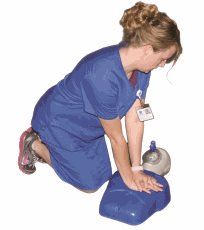CPR Could Save the Life of Someone You Love
 CPR is most effective when initiated immediately after cardiac arrest occurs; however, studies have shown that many individuals hesitate to attempt CPR because they are unsure of the technique, or afraid of causing injury to the victim.
CPR is most effective when initiated immediately after cardiac arrest occurs; however, studies have shown that many individuals hesitate to attempt CPR because they are unsure of the technique, or afraid of causing injury to the victim.
The AHA assures no serious injury will result from attempting CPR, and furthermore – without CPR (even CPR that is incorrectly performed), the victim will most likely die within a few minutes.
CPR should be performed on an individual who:
- Is unconscious and does not respond to taps on the shoulder
- Is not breathing, or does not have a heart beat
The AHA used to recommend a combination of chest compressions and rescue breaths for CPR; however, studies have shown that “hands-only” CPR is just as effective for adults and teens and may remove obstacles for those who are reluctant to perform mouth-to-mouth breathing, especially on a stranger. Hands-only CPR has just two main steps to remember: call 911, and with one hand locked on top of the other, press hard and quickly on the middle of the victim’s chest.
The American Red Cross offers CPR instruction. For more information about CPR classes, call 1-800-RedCross, or visit online at www.redcross.org to register.
When individuals experience a heart attack in a location that is not a hospital, 90 percent of them will die, according to the American Heart Association. The reason for this high mortality rate is that all too often, no action is taken to circulate the victims’ blood until the emergency medical squad arrives. Many lives could be saved if cardiopulmonary resuscitation (CPR) is initiated immediately by someone who is already on the scene.
Health Tips − Hands-Only CPR: Two Easy Steps That Can Save a Life
Studies have shown that hands-only CPR is just as effective in saving teen and adult heart attack victims as conventional compression-and-breaths CPR that was taught in past decades. Hands-only CPR requires only two simple steps:
- Step 1 – Call 911 (or send someone else to call 911 while you begin CPR).
- Step 2 – With the victim lying on his/her back, push hard and fast (a miniumum of 100 beats per minute) in the center of the chest.
Important note:
Even if you are unsure how to perform CPR, any attempt you make to circulate oxygenated blood is preferable to taking no action. Immediate CPR doubles or triples the victim’s chances of survival.
| Posted On : 12/15/2015 9:54:59 AM
Filed under: